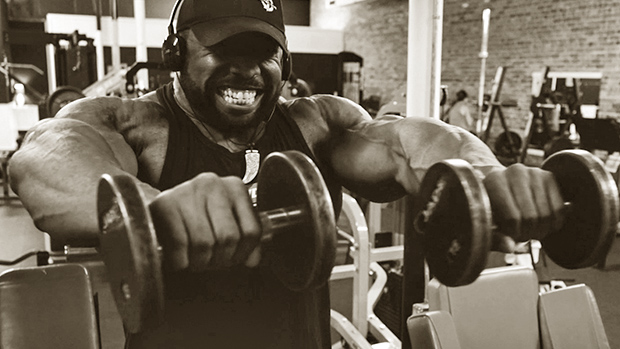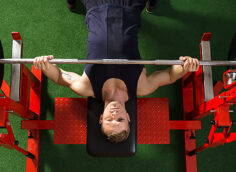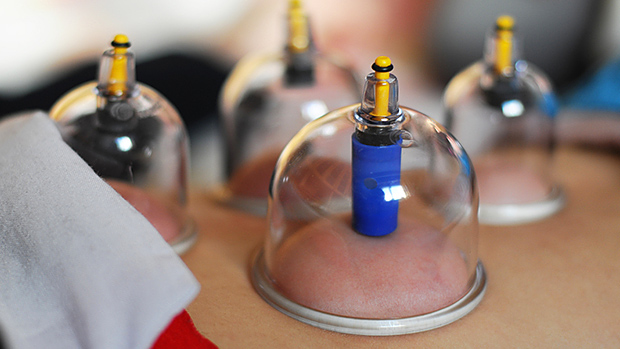Whenever somebody tells me about something "new" in the world of physical conditioning, the first thing I do is check to make sure my wallet is secure. Next, I reference John Jesse's book, Wrestling Physical Conditioning Encyclopedia, published in 1974. I picked up a copy as a young lad and promptly ignored all the excellent advice because... well, the technical term is, "I am an idiot."
No matter what new and exciting thing that has emerged in the last three decades, Jesse already wrote about it. Isometrics, sandbag training, ligament strengthening, Olympic lifts, grip work, swingbells (a.k.a. kettlebells), combining sprinting with calisthenics (I thought I invented that), get-ups, and flexibility training that still outpaces what most of us do today.
In his recommendations for starting out a new year, he has a basic weekly approach. It's simple and has the hallmarks of a great program. I think this advice stands the test of time:
- Three sessions of strength development and injury prevention, with near maximum loads.
- Three sessions of flexibility exercises.
- Three sessions of endurance training.
- The strength development, injury prevention work, and flexibility exercises should be done one day and the endurance training on another.
- The strength development, injury prevention work, and flexibility exercises will slowly increase to an hour and a half a day, and the endurance work to one hour. This will total seven-and-a-half hours training time each week.
Looking Back, Moving Forward
Years ago, I realized that my calendar and my daily schedule simply didn't have enough days and hours. As a father, a college instructor, a husband, a school teacher, a coach, andas an athlete, I began to notice that it was difficult fitting in my usual three hours of training each day. During Junior College, I often trained close to five hours a day with throwing the discus and Olympic lifting. So even at three hours a day, I felt like I was just coasting.
I decided to do something singularly unusual in the annals of fitness. I decided to use my brainpower. I sat down with pen and pad, and looked at the waste in my training programs. I noticed that I did hours of junk work, including assistance exercises that assisted nothing and long, worthless aerobic sessions. I also noted that certain things worked well and took very little time.
I've been free with my insights here at T-Nation from this rather long process. The One Lift a Day program – where the athlete trains just one lift a day – spawned one of the largest discussions in this site's history.
And for the record, if you do "two lifts a day," that's not the program. I will say this one final time: if you honestly squat for 45 minutes, please let me know if this is easy work.
For fat loss and sports performance prep, I still argue that Four Minutes to Fat Loss is the best I can say on the subject. From my experience since then with other athletes, I would no longer consider the thruster a viable option. I now only recommend the front squat.
In other articles, I've included my transformation program. It's a nice training program to simply keep an athlete in shape through the difficult period of transitioning from "off season" to competition. I still consider my Litvinov Workout – mixing heavy front squats with sprints or sleds – to be perhaps the single greatest workout of all time.
You'll note that I always argue for workouts that have clear boundaries. The focus is on whole body movements done with measured intensity (reps, rest time, and weights need to be intelligently focused), and the particular goals of the athlete or fitness trainee stay clearly in vision at all times.
Usually, we discover that "less is more" when it comes to training. Again, I have noted with glee that I have yet to receive an email that the following workout is too easy:
Back squat
- 315 for 30 reps
- Rest
- 275 for 30 reps
- Rest
- 225 for 30 reps
- Go home and rest.
It's only three sets and I did this workout in June 1979. I will be repeating it as soon as I recover.
With the insight that one can improve capabilities in less time, I found the rest of my life also improving. Let's be honest, the four-minute Tabata front squat workout leaves you plenty of time to do things with your career and family. You'll find yourself sitting a lot but that seems to be okay, too.
Recently, I also began to realize that I've been slowly coming to grips with the other side of training... recovery. As odd as it sounds, as one moves past 50 years of age, one doesn't recover like a teenager. My school-age athletes can do an exhausting hour-and-a-half workout, take a sip of water, and then play full court basketball until I kick them out of the gym.
Simply, I have to actually work on and think about recovery. It used to be so simple. My post-workout electrolyte beverage had a flip top and came in a six-pack. I put my feet up and tossed down all six or more. And I would lose bodyfat by walking to the refrigerator.
Alas... youth.
Train Hard, Recover Hard
Before I spiral down into my lost youth, let's look at several options for optimizing the recovery side of hard training and intelligent nutrition. If there's a single key to this discernment process concerning recovery it's this: you must balance the cost to benefit ratio, also known as getting "the biggest bang for the buck."
A one-time investment of a 310-pound Olympic weight set, a single kettlebell, and a doorway pull-up bar can honestly last you a lifetime and provide you with endless hours of training for about $500 (at the most, if you shop around). Or you can spend that much in one day at the spa or the emergency room undoing a bad training decision.
I'm certainly no expert on rehab, injury recovery, or surgery, but like most people, I've spent many hours and dollars on rehab, recovery and surgery. On the first day of my collegiate athletic career, our team trainer simply told us that the key to dealing with hurts, pains, and injury was R.I.C.E.
- Rest
- Ice
- Compression
- Elevation
And, as most of us know, there's still no better formula for the first 24-48 hours after an injury than just lying down with a tight bandage and a bag of ice with the limb elevated. Ice is a miracle worker... for the first day or so.
Intuitively, after that first 48-hour period, we head for heat. I am convinced that heat therapy in any form, from creams to tubs to hot rooms, is the road to healing. So, when I think about restoratives, I turn to warmth. I also turn to stretching. This is important. I've made a career telling people that warming up and pre-training stretching are not only a waste of time, but probably impede progress.
Of course, you don't want to go out there stone cold, but do we really need a half-hour of treadmill, seventy-five twists and contortions, plus a boot camp of calisthenics just to walk over and do a set of pull-ups? With my athletes who insist on long warm-ups, I simply have them do the workout and tell them, "This is the warm-up."
In light of these intuitive truths concerning formal recovery, I tried to figure out what's worked best for me over the past two years. Let's look at the best and brightest.
Bikram Yoga
Yes, I said that. Hot Yoga. There are several reasons I recommend Bikram Yoga for my athletes and none of them relate to the hype. I know that the founder has been on "60 Minutes" and he drives expensive cars, but there's much to be said about the actual classes.

First, the classes are 90-minutes long. If you decide to go twice a week, that's three hours of stretching, pulling, twisting, and relaxing. For many of us, that's two hours and 59 minutes more than we typically stretch and relax in a week.
Next, I must say that the intense heat – nearly always above 103 degrees and often around 110, plus the humidity – does "something" for the body. For me, I sweat. A lot. Seriously folks, I'm talking about sweating that confounds the laws of thermodynamics.
During the session, I can tell you exactly how many pieces of salami I ate at the snack counter during the days meeting, because I swear the damn things are coming out of my forehead. And there's no question that the heat allows me to stretch out that injury I swore I would take care of in 1977. During Bikram Yoga classes, I find the time to deal with four decades of misuse.
But neither the time nor the heat is the real reason I recommend Bikram Yoga. It's the "dialogue." Throughout the entire 90-minute session, the instructor talks to the class and walks you through the stretches and movements. Or, lack of movements, I guess.
For most of us, that's the most coaching we might ever receive. In my youth, I had people like Dick Notmeyer, whose great patience allowed me to learn the snatch and the clean and jerk. "Pull it high and back to you," is the phrase Dick repeated to me countless times, until I figured out that it was easier to pull it high and back to you.
My coach Ralph Maughan had the great skill of being able to watch throw after throw after throw and continue to find faults and corrections no matter how far (or not far) you were throwing.
Where do you get this coaching today? Sure, you might hire Ricky the personal trainer at the gym who was certified after a whole few hours the previous weekend. But what do you get for that? Someone to walk with you over to the next machine, look at the card for you, and tell you that the curl machine works your biceps? Here, send me the money and I'll tell you that squats work your legs. Thank you very much.
A walk-in session for Bikram Yoga around here is fifteen bucks. That works out to ten dollars an hour for someone to make you stretch for 90 minutes. That alone makes it worth considering for me. Whether you believe whichever stretch builds up the ascending colon or clears out the thyroid is beyond this discussion, but for recovery purposes, it's well-worth considering Bikram.
Massage: The Healing Touch
Let's now consider the most popular and, occasionally, suspect recovery method. I remember years ago being told by a European athlete that the problem with the "American system" of training was the lack of restoratives in our general training plan, especially the lack of massage therapy. At the time, I was far too polite to note that there was absolutely no American system for anything in any sport.
Tommy Kono, arguably the greatest Olympic lifter ever to wear "U.S.A." on his chest, notes in his wonderful book, Weightlifting, Olympic Style, that the "American System" is simply to get to the goal as simply and as quickly as one possibly can.
Kono, also a Mr. Universe winner, discussed this issue years ago:
"The U.S. lifters have to go back to the American system of training and not follow what the Europeans are doing. The lifters must return to basics and not have tonnage or intensity govern their training.
Believe it or not, it is the old system of light, medium and heavy; training 3 to 4 times a week and each workout lasting no more than 90 minutes. It is a matter of taxing your muscles and giving ample time to recover. Too many of our current lifters are over-trained and getting injuries because they lack the recovery time."
Whether we get hurt from lack of recovery time or lack of active recovery is still a debate. Most people at some level agree with the basics of massage therapy. It just seems right. Like many athletes, I've tried massage therapy and, to be honest, there are few things in life as good as a good massage.
But like we say about Scotch, there is nothing as a good as a good Scotch and nothing as bad as a bad Scotch. I've had bad Scotch and bad massages. The standard rate seems to be around $85 an hour, and that number slides up quickly depending on the basic economics of your area.
And this is maybe the basic problem with massage. First, you have to develop a relationship with a good masseuse. Getting the masseuse to go deep enough while still addressing the problems of overtraining issues is a task for both you and the masseuse.
I think it takes several visits to get it right. And let's be honest, several massages is not exactly the most difficult prescription you've ever been given. But at the cost of several hundred dollars and several weeks of dialing it in, I have to ask the question again: What about the cost to benefit ratio?
A monthly massage tab of up to a thousand dollars is simply something I can't do. I certainly believe in massages, I enjoy the benefits, but beyond an occasional splurge, I can't justify them as a major restorative tool in my arsenal.
Everyone Into The Hot Tub
On the top end of long-term recovery tools is the hot tub (Jacuzzi). My hot tub was a 40th birthday present to myself and we've gone through two motors and a lot of chemicals in those 10-plus years. The initial cost is high and I was amazed to see one the other day for $10,000.
The upside? Maybe it's my '70s experiences echoing around my head, but hey... it's a hot tub! Few things in life are as good as soaking in a hot tub on a snowy night in Utah. It's good for conversation and companionship too, but that might be outside the bounds of this discussion.

The downside is simple. Did you see that little bit about $10,000?
I also have an outdoor shower hooked up to my garden hose and during the hot summer months, I soak, then cool off in the cold shower. I think one can do this with a normal shower, but I can extend a hot tub with stretching and cold water shower for up to 30 minutes. Again, that's 29 minutes and 30 seconds longer than I stretch in a typical week.
For pure limbic satisfaction, I'm convinced that there's no better choice than a soak. It's more than rehab, it's a party!
Z-Health
I'd be remiss if I didn't offer two cheaper options that I use with my athletes and myself. First, after seeing the work of Dr. Eric Cobb first-hand, and having Chris Shugart report on it, I've been amazed with Z-Health. Although, in full disclosure, I have no idea why it works.
Recently, Dr. Cobb came out with "The Quick Start Guide to Z-Health," a $35 DVD that offers one the biggest bang for the buck Z-Health exercises. After watching the DVD once through, you can follow along doing one side, then the other. The explanations give much of the same benefits as the Hot Yoga dialogue. It isn't perfect as the DVD won't stop and correct your errors, but it isn't bad either.
Using Muscle Tension
Finally, a few years ago I read a book that opened my eyes about how one really gets strong. Oddly, the book was Relax into Stretch: Instant Flexibility Through Mastering Muscle Tension by Pavel Tsatsouline.
Not only are the stretches like Yoga on amphetamines, but there are several short chapters that give insight into the big questions about performance. The section on the reminiscence effect, that wonderful gift from the Cosmos that makes you better when you quit or take time off, is worth the price of the book alone.
I use the tricks from this book daily in my work with athletes, and the techniques work faster than all of the rest of the voodoo I do for injury recovery.
The Bottom Line
The real point of this article isn't to encourage you to sign up for a Yoga class or buy anything. The point is that we need to practice the process of discernment to meet our physical goals. As we're bombarded daily with new ads for pills, diets, and ab-doers, we have to protect our wallets and our time.
To sum:
- Although food and housing might be the most expensive part of keeping your body in shape, if you choose wisely, training equipment can be the cheapest. Maximizing that training equipment can really make you tired and sore, but maybe injured too.
- Recovery aids, beyond nutrition and supplementation, can be very expensive and need to be considered in light of your pocketbook.
- Just because you spend a lot of money doesn't mean you are going to get a lot of return in your restoration budget. Try to do a basic cost to benefit analysis of your training, your lifestyle, and your needs, then see what you can manage. A $10 foam roller can be used to do more good than a bad massage that costs ten times that much.
- Finally, if it is your four-hour daily training sessions killing you, think through your training, too.





